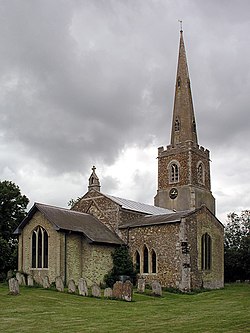Eltisley
| Eltisley | |
| Cambridgeshire | |
|---|---|
 St John the Baptist and St Pandionia, Eltisley | |
| Location | |
| Grid reference: | TL271596 |
| Location: | 52°13’15"N, 0°8’23"W |
| Data | |
| Population: | 421 |
| Post town: | St Neots |
| Postcode: | PE19 |
| Dialling code: | 01480 |
| Local Government | |
| Council: | South Cambridgeshire |
| Parliamentary constituency: |
South Cambridgeshire |
Eltisley is a village in Cambridgeshire, the parish standing hard by the border of Huntingdonshire. The parish borders are marked by isolated trees in many places, rather than following distinct geographical features.[1]
Eastern Brook flows towards Caxton[1] and is a tributary of the Bourn Brook. Eltisley Wood had reached its modern state by the early 19th century; a small wood at Papley Grove, in the north of the parish, is presumably what is left of the woodland that belonged to the prioress of Hinchingbrooke.[1]
Eltisley is found on the A428 road about 5½ miles east of St Neots and about 11 miles west of Cambridge. The population in 2001 was just 421 people.
History
The name 'Eltisley' hints at its origin as an Anglo-Saxon settlement among woodland.[1] Eltisley (Hecteslei) is mentioned in the Domesday Book:
"In Longstow Hundred. The Canons of Bayeux hold 3 hides in Eltisley. Land for 9 ploughs. In lordship 1½ hides; 3 ploughs there; 6 villagers with 10 smallholders have 6 ploughs. 5 cottagers; 6 slaves. Meadow for 3 ploughs; woodland, 20 pigs. The total value is and always was £13. Earl Algar held this manor".
Eltisley has a large village green which was the junction of two ancient roads running from Cambridge to St Neots and from St Ives to Potton. The church stands immediately west of the green and several buildings from the 16th, 17th and 18th centuries stand along its edge, suggesting that the green has been at the centre of the village for a long time. In 1868 it was earmarked for parishioners' recreation and exercise[1] and cricket is played there in summer. Eltisley Cricket Club was established in 1854 and a thatched pavilion stands on the village green.
Until 1868, when it was turned into allotments, another green was sited to the east and in 1456, villagers were distinguished as living in either 'le Estende' or 'le Upende'; it appears that there have been at least two centres to the village since mediæval times.[1]
The parish's population doubled between 1801 and 1871, possibly because of its good road links. In addition to the St Neots-Cambridge and St Ives-Potton roads, the lane towards Caxton may also have been important. After 1871, the population began to decline; in 1961, only 253 people lived in Eltisley parish.[1]
In 2000, the Eltisley Historical Society published The Eltisley Millennium Book, which records the history of the village and the village as it was in the year 2000.[2]
Sights of the village
Two plaques in the churchyard's lych gate commemorate Eltisley men who were killed in the First and Second World Wars.[3]
Some 17 buildings in Eltisley are listed, including a red telephone box,[4] a village pump[5] and a milestone on the St Ives road.[6]
Churches
By around 1230, Eltisley parish church was dedicated to St Pandionia (or Pandwyna), who was said to have been a nun in the parish in the 10th century. Robert Palmer, vicar in 1575, destroyed a well in the churchyard where St Pandionia's body was meant to have been buried originally (in 1576 he was accused of taking church paving for his own use, permitting the vicarage to be used as an ale-house and playing cards when he should have been in church). Her body was said to have been reburied in the church in 1344[1] and the dedication to St John the Baptist was added later.
The oldest part of the current building, the aisled nave, dates from around 1200. The tower and spire were probably built around the 15th century. Robert Palmer may have defaced some monumental effigies during his incumbency and in 1644, William Dowsing destroyed a St Christopher. A strong gust of wind blew out the north window of the chapel in the 17th century and the whole north-west corner was rebuilt in the early 17th century. In 1878, £1,000 was spent on restoring the whole church.[1] It is a Grade II* listed building.[7]
In 1835 a Wesleyan Methodist chapel was constructed; in 1851 the congregation numbered 120 and 45 children came to Sunday school. In 1901 it could hold 140 people but was sold in 1964. A Primitive Methodist chapel was built near the green in 1846 and was still in use in 1968. In 1897, the vicar estimated that 40 out of 90 households in the parish were dissenters.
Trivia
The Prisoner episode, The Girl who was Death used the cricket green for filming.
References
- ↑ 1.0 1.1 1.2 1.3 1.4 1.5 1.6 1.7 1.8 'Parishes: Eltisley', A History of the County of Cambridge and the Isle of Ely: Volume 5 (1973), pp. 46-59. Date accessed: 09 August 2008.
- ↑ Local Heritage Initiative: Eltisley
- ↑ Roll of Honour: Eltisley
- ↑ National Heritage List 11288320: Telephone Kiosk
- ↑ National Heritage List 1127177: Village pump
- ↑ National Heritage List 1163534: Milestone
- ↑ National Heritage List 1127179: Church of St John the Baptist and St Pandionia
Outside links
| ("Wikimedia Commons" has material about Eltisley) |